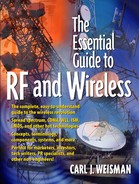INTRODUCTION
WARNING! This book is an oversimplification of a very complex topic. (Your best bet is to keep it away from RF engineers.) When you are done with this book you will not be able to design RF circuits—nor should you want to. However, you should be able to converse intelligently about RF and wireless concepts, understand the lingo, and generally visualize what is going on.
The driving force behind this book is simplicity. It is meant to facilitate a qualitative understanding of an inherently quantitative topic. Many analogies and metaphors are used throughout the book to help you visualize concepts, and where there is a choice between simplicity and factual rigor, the book tends to err on the side of simplicity. My feeling is you don't need to know how to grow[1] tomatoes to eat a pizza and you don't need to know Maxwell's equations to understand RF.
[1] Why are you looking down here? I just told you that you don't need to know it.
This book is intended for people working in and around the RF and wireless industry without a technical degree. The assumption I have made is that you know absolutely nothing about electronics, RF, or any other arcane science. And in an effort to keep things fun, I have included only one formula for you to memorize in the entire book; here it is:
![]()
This equation means the more books which are bought, the more money I make. That's it—you can kick back and relax.
In this book the terms RF and wireless are used interchangeably just to break up the monotony. Wireless is primarily a marketing term used to describe a subset of newer, RF applications, which include things like cellular telephony and paging, to mention a few. In this book the cellular phone is frequently used as an example to help you visualize what is going on. In fact, it is beat to death. Oh well, it is simple, everyone knows what it is, and it gets the point across. Remember, the goal here is simplicity.
There are two things to note. First, this book uses block diagrams to describe RF systems. If there were another way, I would have chosen it. Unfortunately, it is the simplest way to explain what is going on. Block diagrams consist of strange symbols connected by lines in a systematic way. In some ways, block diagrams are like a foreign language which RF engineers use to communicate what is happening in their RF world. When you are done reading the book, you will be able to interpret rudimentary block diagrams. It will be like vacationing in France after listening to a Berlitz tape on French for half an hour. You'll know just enough RF to get into trouble.
Second, every attempt is made in this book to keep the subject matter fun. Heaven knows the subject matter can use it.
